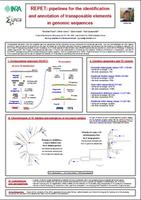
2010
Plant & Animal Genome (PAG) XVIII Conference , January 9-13, 2010, Town & Country Convention Center in San Diego, California, USA.
11 Jan 2010 REPET: pipelines for the identification and annotation of transposable elements in genomic sequences.
Timothée Flutre, Olivier Inizan, Claire Hoede, Hadi Quesneville
Transposable elements (TEs) account for a large part of most eukaryotic genome sequences and have a huge impact on genome structure, function and evolution. We present REPET a bioinformatics package displaying two parallelized pipelines, TEdenovo and TEannot, currently used in 15 genome projects (plants, fungi, insects and animals). The comprehensive TE annotation they delivered is the basis to explore the evolutionary diversification of TEs and their functional impacts on genomes.
The TEdenovo pipeline searches for repeats via a self-alignment of the input genomic sequences, then clusters the resulting high-scoring segment pairs, and finally builds consensus from multiple sequence alignments. At the crucial step of repeats clustering, several programs are combined to improve the efficiency of the approach. When applied on D. melanogaster, our de novo pipeline is able to retrieve the complete sequence of 54 TE families knowing that only 55 have at least 2 intact, full-length copies. Finally, phylogenies of consensus show that a given TE family is better represented by several de novo consensus representing structural variants of this family.
The TEannot pipeline aligns a TE library with genomic sequences using several alignment programs. The matches are statistically filtered and then combined all together. Simple short repeats are annotated along the way. Then we apply a two-step strategy to connect nested fragments belonging to the same TE copy, and thus to reconstruct the insertion patterns. Finally, the annotation is delivered in common formats allowing their subsequent analysis in genome browser and annotation editor.
[Download pdf: 607.02 kB]
Creation date: 20 May 2010
 eZ Publish
eZ PublishPublication supervisor: A-F. Adam-Blondon
Read Credits & General Terms of Use
Read How to cite










